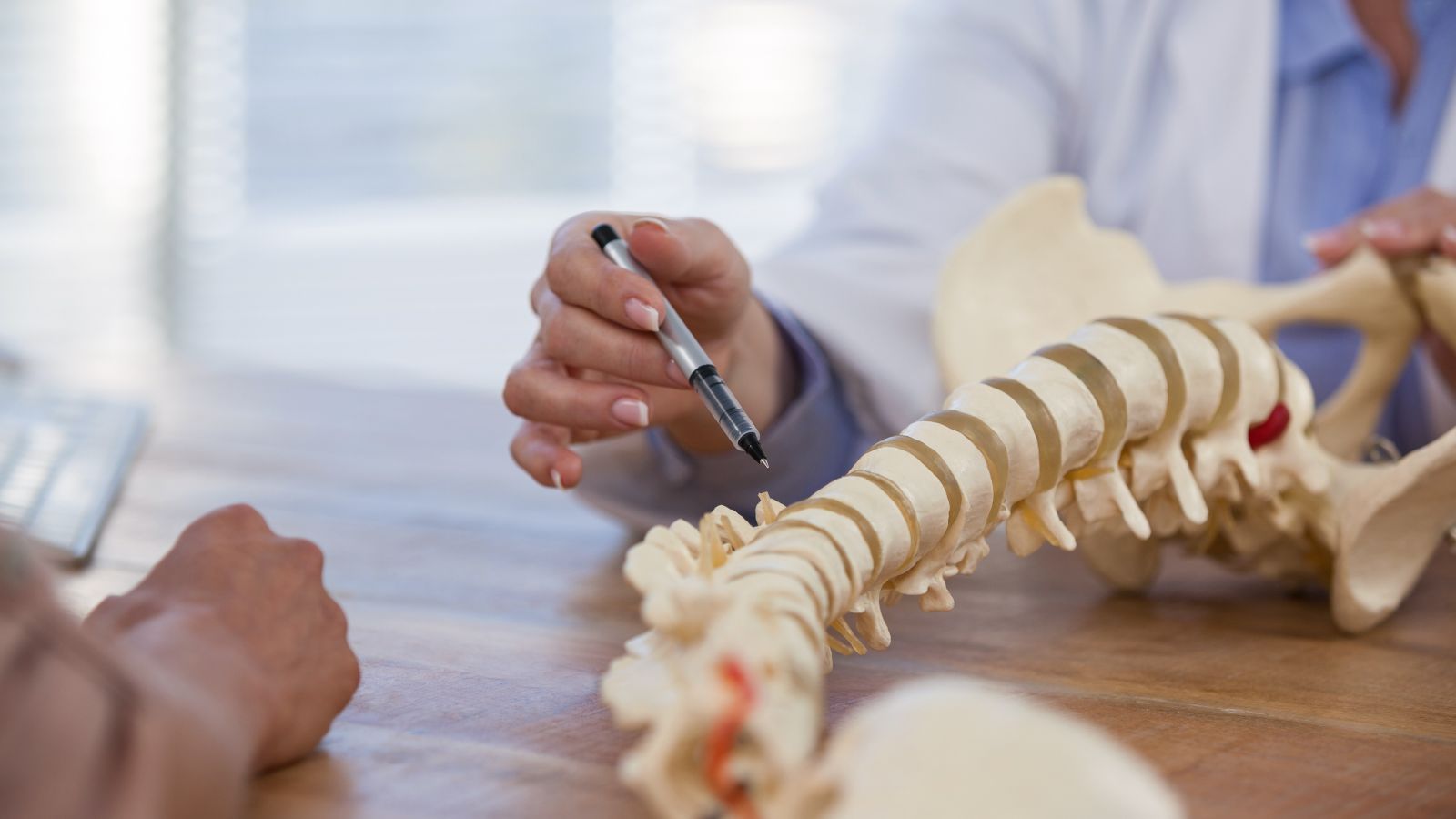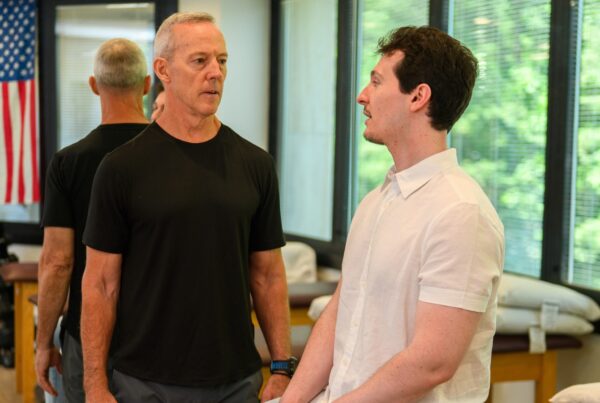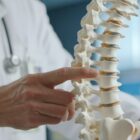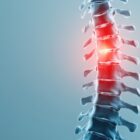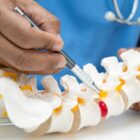“When can I move my neck again?” “Will I ever get back to my normal activities?” These questions race through your mind when the initial relief of successful neck surgery gives way to the reality of recovery. After ACDF surgery, you want more than just exercise instructions. You want to feel confident in your healing journey.
Your Recovery Roadmap: Four Phases to Reclaiming Movement
Your recovery has clear phases. Each phase includes specific exercises after cervical spine surgery:
Phase 1: First Steps (0-2 Weeks) – Protecting Your Fusion
During these first critical weeks, protect the surgical area and manage discomfort. While traditional “exercise” isn’t recommended yet, gentle movements are important for circulation and lung function.
- Deep breathing: Promotes circulation and reduces stress, box-breathing, specifically, is an excellent technique to employ.
- Gentle walking: Begin with short, frequent walks around your home.
- Proper posture education and awareness: Maintaining your neck in a neutral position is important. Correct posture and body mechanics should be a priority during exercise and daily activities.
- Cervical collar These come in two forms: rigid and soft. Rigid collars are meant to minimize all head and neck movement. They automatically put your head and neck in the correct posture. Soft collars offer no structural support and do not limit movement. They are meant for comfort only. For many patients, particularly those who have had one level surgery, there is no collar requirement at all.
Phase 2: Breaking Free (2-6 Weeks) – Finding Movement Again
The key variable in this stage is whether your surgeon has ordered a rigid cervical collar for you to wear or not. There is no standard duration for this, although most surgeons will eliminate collar wearing by week six post-surgery.
You should follow your surgeon’s instructions to the letter regarding collar wearing.
When you do come out of the collar (or if you were never prescribed one), many surgeons will advise a bit of gentle movement to prevent stiffness and muscle weakness. These are typically not active exercises per se, but rather encouragement to begin to move your head as you normally would to perform your activities of daily living.
Usually strenuous activities or exercise are still not permitted during his phase.
Phase 3: Building Power (6-12 Weeks) – Strengthening Your Support System
As fusion progresses and pain decreases, focus shifts to actively rebuilding strength and range of motion. This is when most patients are referred to a physical therapist for this purpose. These are some typical exercises your therapist might prescribe.
- Gentle Isometric exercises: Push lightly with your hand against your forehead or the back of your head. Keep your neck still.
- Shoulder blade squeezes: Pull your shoulder blades together, hold briefly, then release.
- Posture exercises: Strengthen the muscles that support proper alignment.
Phase 4: Reclaiming Your Life (12+ Weeks) – Advanced Recovery
When your surgeon confirms appropriate healing, you’ll progress to more a comprehensive conditioning.
- Core exercises after ACDF surgery: Modified planks, bridges, and gentle abdominal work.
- Upper body range of motion & strengthening: Light weights and gentle movements with proper form.
- Low-impact cardio: Walking, stationary cycling, or elliptical training.
It's time to get back
to doing what you love.
Neck Fusion Success: Top-Recommended Exercises After ACDF Surgery
Your physical therapist will create a personalized program. These are some common exercises that may be prescribed.
Restore Your Range: Key Neck Mobility Exercises
These gentle movements help maintain flexibility without stressing your fusion:
- Forward and Backward Tilts: Slowly nod your head forward and backward
- Side Bends: Carefully tilt your ear toward your shoulder
- Gentle Turns: Gradually turn your head to look over each shoulder
Pro Tip: Initially, perform these movements in front of a mirror to ensure proper form and alignment.
No-Movement Muscle Building: Isometric Strengthening Techniques
These isometric exercises build strength without movement, making them ideal for early recovery:
- Forward Pressure: Place your palm on your forehead and push gently while keeping your head still
- Side Pressure: Place your hand against the side of your head and press while maintaining position
- Backward Pressure: Place your hands behind your head and press back while holding position
Supporting Cast: Upper Back and Shoulder Exercises That Protect Your Neck
Strong supporting muscles improve neck function and reduce strain:
- Shoulder Blade Pinches: Squeeze shoulder blades together, hold, then release
- Wall Slides: Stand with back against wall, slide arms up in a snow-angel pattern
- Doorway Stretches: Stand in doorway with arms on frame, step forward to stretch
Safety First: Protecting Your Fusion While Building Strength
While exercise promotes healing, safety remains paramount:
- Always get approval from your surgeon before beginning any exercise program
- Start slowly with a lower intensity than you think necessary
- Stop immediately if you experience pain, numbness, tingling, or weakness
- Avoid high-impact activities until fully cleared by your medical team
- Never push through pain – mild discomfort is different from beneficial stretch
The NJ Advantage: Personalized Recovery With Academic Excellence
“Patients who get the right support during rehab tend to do better in the long run,” says the surgical team at Neurosurgeons of New Jersey. “The key is starting with the right exercises at the right time.”
At Neurosurgeons of New Jersey, we recognize that every patient’s recovery journey is unique. Our team works together. We blend expert knowledge with caring, personal support. We have strong ties to the community and are just minutes from New York City. We’re proud to provide great surgical results along with the support and convenience you need for your recovery.
From Patience to Progress: Your Journey Back to Active Living
Recovering from neck fusion surgery requires patience, consistency, and expert guidance. A structured program with the best exercises after ACDF surgery can help you recover. It’s tailored for your specific needs. This method boosts your surgery outcomes and helps you get back to an active life.
Regular participation in your recovery exercises delivers numerous benefits:
- Supports the healing process for better surgical results
- Improves overall neck mechanics to reduce future problems
- Prevents muscle weakness that leads to poor posture and recurring pain
- Accelerates your return to daily activities for enhanced quality of life
Do you have questions about physical therapy exercises after ACDF surgery, or are you ready to develop your personalized recovery plan? Request a consultation with our doctors who specialize in post-surgical rehabilitation.
FAQs
When can I start exercising after ACDF surgery?
You can typically start gentle movement, like walking, right after surgery. Structured exercises typically start 2 to 6 weeks later. This begins after your surgeon approves it.
Are neck exercises safe after ACDF surgery?
Specific, surgeon-approved neck exercises are not only safe but recommended as part of recovery. These must be introduced at the appropriate time and performed with proper technique.
What exercises should I avoid after neck fusion?
Initially, avoid high-impact activities, heavy lifting, and any exercises that cause pain. Your surgeon will provide specific restrictions based on your fusion level and recovery progress.
How long until I can return to my regular exercise routine?
Most patients can return to most regular activities about 3 months after surgery. Full activity is usually possible by 6 months. Your surgeon will give you tailored advice. This will depend on how well you heal and how stable your fusion is.

About Ridgewood
Our team of board certified physicians, located in Ridgewood, New Jersey, are dedicated to bringing you the latest developments and treatment options for spinal surgery. We strive to produce the most clarified & clear content to help you make informed decisions on your medical journey. The road to feeling like your true self should not feel lonely- Let us help you. Please call us to schedule a consultation and speak to one of our team members.

